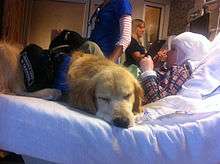Seizure response dog

A Seizure Response Dog can be brought to restaurants or other businesses.

Service dog for a boy with autism and seizures calms him during hospital stay.
A seizure response dog (SRD) (also known as seizure dog) is a dog demonstrating specific assisting behaviour during or immediately after a person's epileptic seizure.[1][2] When reliably trained such dogs can serve as service dogs for people with epilepsy.[3] Tasks for seizure dogs may include, but are not limited to:[4][5][6]
- Find someone to help
- Activate an emergency response system
- Stimulate a person to help them "wake up" after a seizure
- Act as a brace to help the person up
- Retrieve a phone or medication
- Physically remove the patient from an unsafe situation ( i.e. middle of a street )
A dog demonstrating specific behaviour prior to a persons epileptic seizure is also referred to as seizure alert dog (SAD).[2][7][8] Reports suggest that some dogs can be trained to anticipate epileptic seizures.[3][7] However, this ability has been questioned.[9][10][11]
Seizure response and seizure alerting behaviour may spontaneously develop in dogs living with children and adults with epilepsy.[1][2][8]
References
- 1 2 Di Vito L1, Naldi I, Mostacci B, Licchetta L, Bisulli F, Tinuper P (2010). "A seizure response dog: video recording of reacting behaviour during repetitive prolonged seizures". Epileptic Disord. 12 (2): 142–5. doi:10.1684/epd.2010.0313. PMID 20472528.
- 1 2 3 Kirton A1, Wirrell E, Zhang J, Hamiwka L (2004). "Seizure-alerting and -response behaviors in dogs living with epileptic children". Neurology. 62 (12): 2303–5. doi:10.1212/wnl.62.12.2303. PMID 15210902.
- 1 2 Kirton A1, Winter A, Wirrell E, Snead OC (2008). "Seizure response dogs: evaluation of a formal training program". Epilepsy Behav. 13 (3): 499–504. doi:10.1016/j.yebeh.2008.05.011. PMID 18595778.
- ↑ "Seizure Dogs". Paws With A Cause. Retrieved 2014-10-01.
- ↑ "Seizure response dogs with special training". Canine Assistants. Retrieved 2014-10-01.
- ↑ "Seizure Dogs". Epilepsy foundation. Retrieved 2014-10-01.
- 1 2 Strong V; Brown S; Walker R (1999). "Seizure-alert dogs--fact or fiction?". Seizure. 8 (1): 62–5. doi:10.1053/seiz.1998.0250. PMID 10091851.
- 1 2 Dalziel DJ1, Uthman BM, Mcgorray SP, Reep RL (2003). "Seizure-alert dogs: a review and preliminary study". Seizure. 12 (2): 115–20. doi:10.1016/S105913110200225X. PMID 12566236.
- ↑ Doherty, MJ; Haltiner, AM (Jan 23, 2007). "Wag the dog: skepticism on seizure alert canines.". Neurology. 68 (4): 309. doi:10.1212/01.wnl.0000252369.82956.a3. PMID 17242343.
- ↑ Ortiz R; Liporace J (2005). "Seizure-alert dogs: observations from an inpatient video/EEG unit". Epilepsy Behav. 6 (4): 620–622. doi:10.1016/j.yebeh.2005.02.012. PMID 15907758.
- ↑ Krauss GL; Choi JS; Lesser RP (2007). "Pseudoseizure dogs". Neurology. 68 (4): 308–309. doi:10.1212/01.wnl.0000250345.23677.6b. PMID 17242342.
External links
- Seizure-alert dogs National Geographic News article
This article is issued from Wikipedia - version of the 6/5/2016. The text is available under the Creative Commons Attribution/Share Alike but additional terms may apply for the media files.
